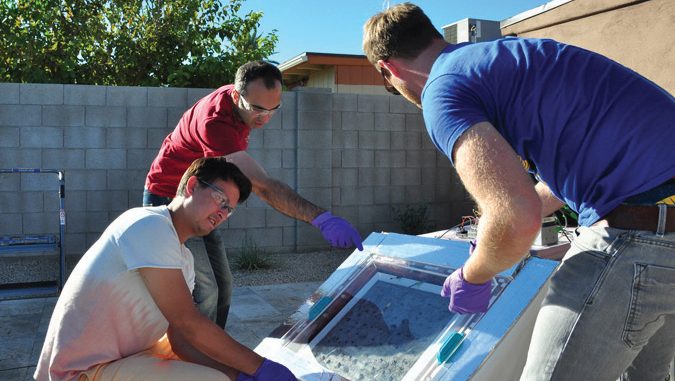
It is estimated that fresh water makes up only 2-3 per cent of the total water resources on earth, with most of it frozen in the form of glaciers and ice caps. The rapid increase in global population has stressed the world’s available water resources, and cities like Cape Town in South Africa, and Shimla in India are both facing a severe water crisis. While desalination could be an alternative to using surface water, it is restricted by geography and is an expensive process that consumes a large amount of electricity.
As a solution to this problem, a team of scientists from UC Berkeley, USA has developed a prototype for a water harvester that can collect water from the atmosphere using sunlight and a water absorber, which is a highly porous material called a metal-organic framework (MOF). The water harvester collects drinkable water from dry desert air over the course of an entire day and night. For this purpose, it uses the MOF that absorbs water during the night, and through solar heating during the day, releases it to be condensed and collected. MOFs are solids with so many internal channels and holes that a mere sugar-cube-sized water absorber could have an internal surface area that is equivalent of six football fields. Its surface area can easily absorb gases or liquids and quickly release them when heated.
The structure of the harvester can be described as a box placed inside another box. The inner box holds a 2-square-foot bed of MOF grains that are open to the air for absorbing moisture. The outside box is a two-foot plastic cube with a transparent top and sides. The top is left open at night to let air flow in, allowing contact with the MOF. It is then closed during the day so the box can heat up like a greenhouse to drive water back out of the MOF. The released water condenses on the inner surface of the outer box and falls to the bottom, where it can be collected with a pipette. Various types of MOFs are already being tested for applications such as absorbing water, packing more gas into the tanks of hydrogen-fuelled vehicles, absorbing carbon dioxide from smokestacks and storing methane. The advantage of such a device is that it can extract water even in areas with low levels of humidity. That, coupled with its low operational costs, makes it ideal for inhabitants of arid regions. The device also functions well at ambient temperatures without electricity and so it does not depend on a specific location to be able to operate.
The current MOFs being used (MOF-801) are made of zirconium, which can be expensive. They can extract about 200 ml of water for every kilogram of MOF. However, the team has developed a new aluminium-based MOF (MOF-303), which is 150 times cheaper, and has been proven to show that it can absorb twice as much water as the MOF-801. The researchers are expecting the per kilogram amount of water absorbed daily by the new MOF to be about 400 ml, or about 1.5 cups of water.
The research team recently conducted a field trial in Scottsdale, in the Arizona desert, to test the device outside the laboratory. The humidity levels in the region can vary from 40 per cent at night to 8 per cent during the day. The practical demonstration showed that the amount of water harvested could be scaled up by simply adding more of the water absorber inside the device. In the next phase, the team will test the aluminium-based MOF in Death Valley, California, during the summer, where day-to-night temperatures can vary from 43o to 21o Celsius, with the humidity at night dropping to as low as 25 per cent.
The industry has shown active interest in this technology and there are reportedly several start-up companies interested in taking this technology from the lab to the market using the cheaper aluminium-based MOF. The team is also collaborating with King Abdul Aziz City for Science and Technology in Riyadh, Saudi Arabia, as part of their joint research at the Centre of Excellence for Nanomaterials and Clean Energy. Although the technology is still being tested on a smaller scale, a commercial-scale prototype could be ready in a few years as a result of the recent advances made in MOF technology.
